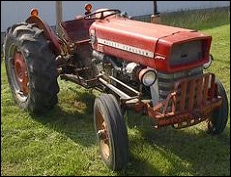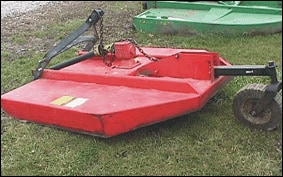Rancher Died When He Was Crushed Beneath an Overturned Tractor

SUMMARY
A 59-year old rancher died on August 10, 2001 from injuries received when he was crushed beneath the overturned tractor that he was operating. OKFACE investigators concluded that to prevent similar occurrences, employers should:
- Maintain tractors and similar farm equipment in safe operating condition, including original safety-related features and any retrofits designed and recommended by the equipment manufacturer.
- Inspect areas in which mobile equipment is to be operated prior to performing the work to identify and control actual and potential hazards.
- Prevent operation of a tractor or other farm equipment by any person impaired by alcohol or drug consumption.
- Familiarize themselves and their employees with farm safety documents and training materials.
INTRODUCTION
A 59-year old rancher died on August 10, 2001 from injuries received when he was crushed beneath the overturned tractor that he was operating. The decedent was a business owner who had been a part-time farmer/rancher for many years. OKFACE investigators reviewed the death certificate, medical examiner’s report, county sheriff’s report, and newspaper articles on the incident. OKFACE investigators interviewed the county sheriff and a subject matter expert on the tractor involved in the incident.
At the time of the incident, the victim was operating a tractor equipped with a brush hog. The tractor, which was manufactured no later than 1975, was generally in good operating condition at the time of the incident but was not equipped with a rollover protective structure or a seat belt. OKFACE investigators did not identify any objective evidence that the farm operation had a formal safety program.
 |
 |
| Figure 1. Tractor similar to the one used by the rancher. | Figure 2. Brush hog. |
INVESTIGATION
The temperature at the time of the incident was approximately 98°F, and there had been no measurable precipitation for at least 10 days. The decedent was using a tractor (similar to the one shown in Figure 1) equipped with a brush hog to mow a hayfield located along a creek approximately three to four miles from his home. He was last seen at approximately 3:30 p.m. when he drove the tractor from his home to the hayfield.
There were no eyewitnesses to the incident, but physical evidence indicated the victim was mowing tall grass, approximately 18-24 inches deep, above the creek along an embankment approximately five feet in height when the bank collapsed. The operator steered the left rear tire close to the edge of the embankment and was apparently trying to steer away from the edge when the weight of the tractor caused the collapse. The tractor rolled into the creek coming to rest on top of the operator in approximately two feet of water.
When the operator did not arrive at home as expected, searchers went to the field and discovered the overturned tractor and the victim in the creek shortly after 11:00 p.m. The sheriff and local volunteer emergency responders arrived on the scene shortly thereafter. An automobile wrecker truck was used to raise the tractor, and the victim was transported to a hospital approximately 30 miles away where he was pronounced dead.
CAUSE OF DEATH
The medical examiner listed the immediate cause of death as traumatic asphyxiation due to blunt chest trauma. The medical examiner’s report indicated a post-mortem blood alcohol level of 0.12%.
RECOMMENDATIONS
Recommendation #1: Employers should maintain tractors and similar farm equipment in safe operating condition, including original safety-related features and any retrofits designed and recommended by the equipment manufacturer.
Discussion: Although the tractor was otherwise reportedly in good condition, OKFACE investigators determined that the tractor was not equipped with a rollover protective structure (ROPS) or seatbelt. The tractor was not originally equipped and delivered from the manufacturer with a ROPS or seatbelt; however, a retrofit has been available for several years. The installation of such equipment, as required by Occupational Safety and Health Administrative regulations for equipment used by employees, may have prevented the fatal injuries sustained by the operator when the tractor overturned on top of him.
Recommendation #2: Employers should inspect areas in which mobile equipment is to be operated prior to performing the work to identify and control actual and potential hazards.
Discussion: OKFACE investigators were unable to determine whether or not the creek had previously undercut the area of the bank that collapsed, leaving it as an unsupported overhang. The height of the embankment presented an obvious hazard to the operation of mobile equipment along the edge of the creek. Additionally, the height of the grass may have partially obscured the operator’s view of the edge of the bank and/or affected his judgment as to the location of the exact edge of the embankment thereby increasing the risk of exposure to the hazard. Prior inspection of the area and clear marking of a safe operating perimeter could have prevented the operator from encroaching on the embankment’s edge and ultimately causing collapse of the creek bank. Pre-operation hazard analysis is a critical element of any safety and health management system and should be integrated into all business operations.
Recommendation #3: Employers should prevent operation of a tractor or other farm equipment by any person impaired by alcohol or drug consumption.
Discussion: Post-mortem tests indicated the operator’s blood alcohol level exceeded the legal limit for operating a motor vehicle in the State of Oklahoma. This level of impairment, in combination with the extreme heat on the day of the incident, may have affected the operator’s decision-making ability regarding the degree of hazard and/or the tractor’s proximity to the hazard.
Recommendation #4: Employers should familiarize themselves and their employees with farm safety documents and training materials.
Discussion: Small family farms may not have a formal safety program or written safety procedures; however, the information to promote farm safety and health is available from many sources and in a variety of media. Safety training is a critical component of an effective farm safety program, whether or not the program has been formally developed, and the farm owner must ensure that all workers, including family members and part-time or occasional employees, participate in quality safety training that promotes safe job performance on the farm. Manufacturers and operating manuals for equipment such as the tractor involved in this incident are critical sources of safety information on the operation of such equipment. Employers should maintain equipment manuals and manufacturer safety information for future reference.
Additional resources for documents and training videos include:
- NIOSH National Ag Safety Database (http://www.nasdonline.orgexternal icon) (Link updated 10/5/2009)
- USDOL Occupational Safety & Health Administration’s OSHA Fact Sheets (https://www.osha.govexternal icon)
- University-sponsored programs such as Purdue University’s Agricultural Safety and Health Program (https://engineering.purdue.edu/~agsafety/IRSHC/external icon) (Link updated 4/1/2013)
- University extension services such as the University of Minnesota’s Farm Safety & Health Information Clearinghouse (http://safety.cfans.umn.edu/external icon) (Link updated 12/11/2007)
- Private safety resources such as
- National Safety Council (http://www.nsc.org/Pages/Home.aspxexternal icon) (Link updated 4/1/2013)
- Saftek, Inc. (http://www.saftekinc.com/external icon (Link updated 4/1/2013)), and
- Internet web links such as
- Oklahoma State University’s Farm Safety and Agriculture Online Library (http://ehs.okstate.edu/links/farm.htmexternal icon) (Link updated 4/1/2013)
- North Dakota State University Extension Service’s Safety Links (http://www.ag.ndsu.nodak.edu/abeng/links/safety.htm) (Link no longer valid, 12/11/2007) and
- US Department of Agriculture’s Farm Safety Program (http://www.reeusda.gov/pas/AGSYS/FARMSAFE/Farmsafe.htm) (Link no longer valid, 9/13/2005).
REFERENCES
29 CFR 1928.51, Roll-over protective structures (ROPS) for tractors used in agricultural operations Farm Safety Association, Farm Tractor Safety: A Guide to Safe Farm Tractor Operation
The Oklahoma Fatality Assessment and Control Evaluation (OKFACE) is an occupational fatality surveillance project to determine the epidemiology of all fatal work-related injuries and identify and recommend prevention strategies. FACE is a research program of the National Institute for Occupational Safety and Health (NIOSH), Division of Safety Research.These fatality investigations serve to prevent fatal work-related injuries in the future by studying the work environment, the worker, the task the worker was performing, the tools the worker was using, the energy exchange resulting in injury, and the role of management in controlling how these factors interact.
To contact Oklahoma State FACE program personnel regarding State-based FACE reports, please use information listed on the Contact Sheet on the NIOSH FACE website. Please contact In-house FACE program personnel regarding In-house FACE reports and to gain assistance when State-FACE program personnel cannot be reached.
Back to NIOSH FACE Web
